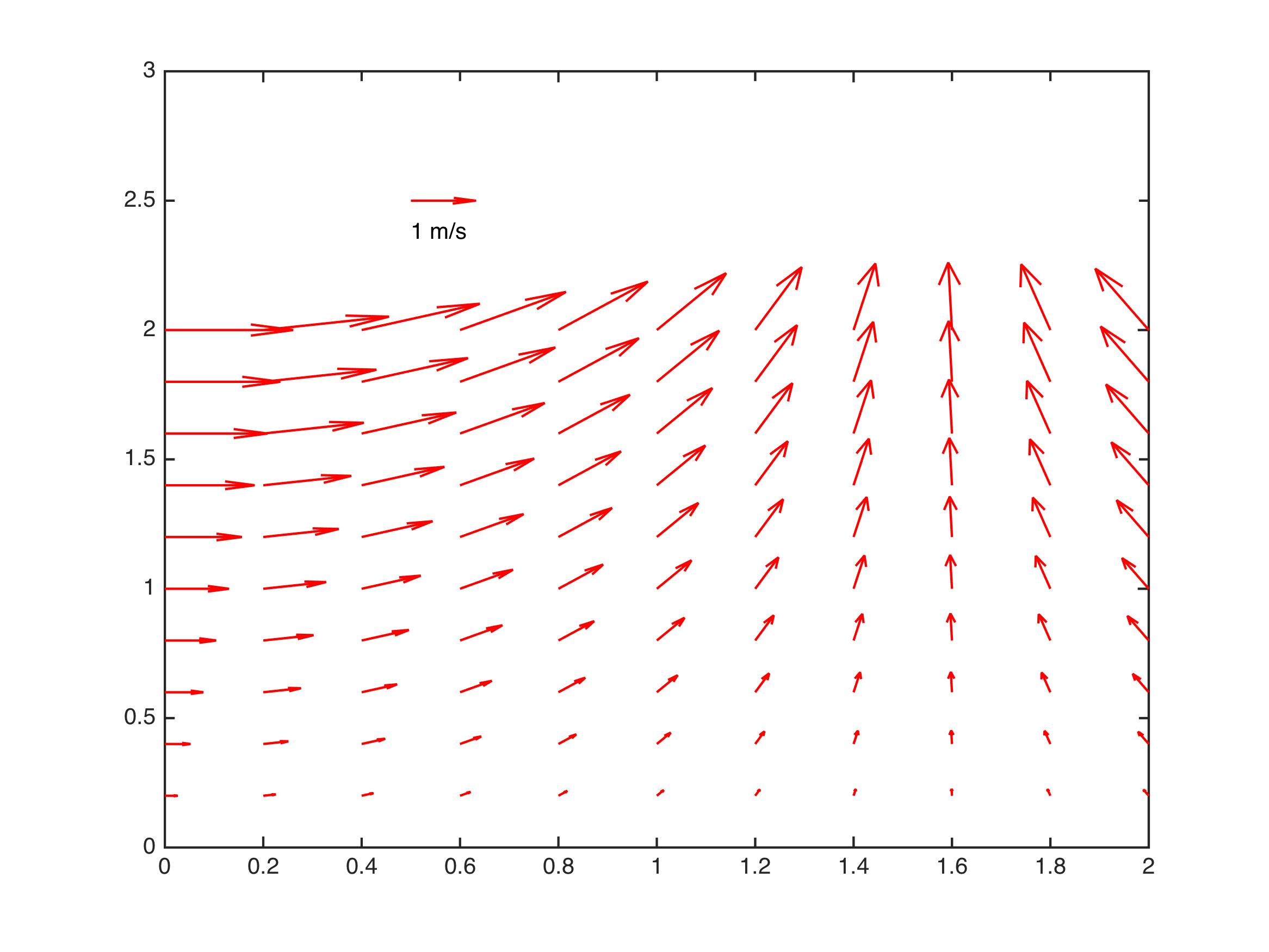Matlab自带函数中不包含构造 quiver 函数注释过程,本文参照 matplotlib 中 quiverkey 函数,构造类似函数为 Matlab 中 quiver 矢量场进行标注。
quiverkey函数
首先看 matplotlib 中 quiverkey 如何定义的
quiverkey(*args, **kw)
Add a key to a quiver plot.
Call signature::
quiverkey(Q, X, Y, U, label, **kw)
Arguments:
*Q*:
The Quiver instance returned by a call to quiver.
*X*, *Y*:
The location of the key; additional explanation follows.
*U*:
The length of the key
*label*:
A string with the length and units of the key
Keyword arguments:
*coordinates* = [ 'axes' | 'figure' | 'data' | 'inches' ]
Coordinate system and units for *X*, *Y*: 'axes' and 'figure' are
normalized coordinate systems with 0,0 in the lower left and 1,1
in the upper right; 'data' are the axes data coordinates (used for
the locations of the vectors in the quiver plot itself); 'inches'
is position in the figure in inches, with 0,0 at the lower left
corner.
*color*:
overrides face and edge colors from *Q*.
*labelpos* = [ 'N' | 'S' | 'E' | 'W' ]
Position the label above, below, to the right, to the left of the
arrow, respectively.
*labelsep*:
Distance in inches between the arrow and the label. Default is
0.1
*labelcolor*:
defaults to default :class:`~matplotlib.text.Text` color.
*fontproperties*:
A dictionary with keyword arguments accepted by the
:class:`~matplotlib.font_manager.FontProperties` initializer:
*family*, *style*, *variant*, *size*, *weight*
Any additional keyword arguments are used to override vector
properties taken from *Q*.
The positioning of the key depends on *X*, *Y*, *coordinates*, and
*labelpos*. If *labelpos* is 'N' or 'S', *X*, *Y* give the position
of the middle of the key arrow. If *labelpos* is 'E', *X*, *Y*
positions the head, and if *labelpos* is 'W', *X*, *Y* positions the
tail; in either of these two cases, *X*, *Y* is somewhere in the
middle of the arrow+label key object.
Additional kwargs: hold = [True|False] overrides default hold state
可以看到主要参数有这么些个
- quiver绘图指针
- 图例位置
X, Y - 标注大小
U - 标注单位字符
- 其他参数
1). 输入坐标X, Y单位
2). (文字)标注在图例哪个位置
3). 标注与图例相对距离
4). 标注字体颜色
使用方法:
对应Matlab函数也应该使用这么个流程
- 使用quiver绘图
- 将quiver返回指针与图例位置坐标和大小等作为参数传入
示例
[x,y] = meshgrid(0:0.2:2,0:0.2:2);
u = cos(x).*y;
v = sin(x).*y;
figure;
Qh = quiver(x,y,u,v);
quiverkey(Qh, 0.5, 2.5, 1, 'm/s', 'Color', 'r', 'Coordinates', 'data')
最终效果图

代码
function Q = quiverkey(Q, X, Y, U, label, varargin)
%QUIVERKEY legend for quiver
%
% QUIVERKEY(Q, X, Y, U, label)
%
% Arguments:
% Q : The quiver handle returned by a call to quiver
% X,Y : The location of the legend
% U : The unit length. If U<0, the arrow will be reversed
% label : The string with the length and units of the key
%
% Addition arguments:
% Coordinates = [ 'axes' | 'data'(default) ]
%
% 'axes' & 'figure' : 'axes' and 'figure' are normalized
% coordinate systems with 0,0 in the lower left
% and 1,1 in the upper right;
% 'data' : use the axes data coordinates
%
% LabelDistance : Distance in 'coordinates' between the arrow and the
% label. Deauft is 0.1 (units 'axes').
%
% Color : overrides face and edge colors from Q.
%
% LabelPosition = [ 'N' | 'S'(default) | 'E' | 'W' ]
%
% Position the label above, below, to the right,
% to the left of the arrow, respectively.
%
% LabelColor : defaults to black
%
% Examples:
%
% [x,y] = meshgrid(0:0.2:2,0:0.2:2);
% u = cos(x).*y;
% v = sin(x).*y;
% figure; Qh = quiver(x,y,u,v);
% quiverkey(Qh, 0.5, 2.5, 1, 'm/s', 'Color', 'r', 'Coordinates', 'data')
%
% Author:
% li12242 - Department of Civil Engineering in Tianjin University
% Email:
% li12242@tju.edu.cn
%
%% get input argument
if nargin < 5
error('Input arguments" Number incorrect!')
end
if isempty(varargin) && mod(length(varargin), 2) ~= 0
error('Input arguments donot pairs!')
else
[CoorUnit, LabelDist, Color, LabelPosition, LabelColor] = getInput(varargin);
end
%% add legend arrow
% get original data
xData = get(Q, 'XData'); yData = get(Q, 'YData');
uData = get(Q, 'UData'); vData = get(Q, 'VData');
% get axes properties
haxes = get(Q, 'Parent');
xLim = get(haxes, 'XLim'); yLim = get(haxes, 'YLim');
NextPlot = get(haxes, 'NextPlot');
% set axes properties
set(haxes, 'NextPlot', 'add')
if strcmp(CoorUnit, 'axes')
% position of legend arrow
xa = xLim(1) + X*(xLim(2) - xLim(1));
ya = yLim(1) + Y*(yLim(2) - yLim(1));
else
xa = X; ya = Y;
end
% add legend arrow into data vector
xData = [xData(:); xa]; yData = [yData(:); ya];
uData = [uData(:); U]; vData = [vData(:); 0];
% reset data
set(Q, 'XData', xData, 'YData', yData, 'UData', uData, 'VData', vData);
set(Q, 'Color', Color)
%% add text
dx = LabelDist*(xLim(2) - xLim(1));
dy = LabelDist*(yLim(2) - yLim(1));
% set position of label
switch LabelPosition
case 'N'
xl = xa; yl = ya + dy;
case 'S'
xl = xa; yl = ya - dy;
case 'E'
xl = xa + dx; yl = ya;
case 'W'
xl = xa - dx; yl = ya;
end% switch
th = text(xl, yl, [num2str(U), ' ', label]);
set(th, 'Color', LabelColor);
% turn axes properties to original
set(haxes, 'NextPlot', NextPlot)
end% func
%% sub function
function [CoorUnit, LabelDist, Color, LabelPosition, LabelColor] = getInput(varcell)
% Input:
% varcell - cell variable
% Output:
%
nargin = numel(varcell);
%% set default arguments
CoorUnit = 'data';
LabelDist = 0.05; % units 'axes'
Color = 'k';
LabelPosition = 'S';
LabelColor = 'k';
%% get input arguments
contour = 1;
while contour < nargin
switch varcell{contour}
case 'Coordinates'
CoorUnit = varcell{contour+ 1};
case 'LabelDistance'
LabelDist = varcell{contour+ 1};
case 'Color'
Color = varcell{contour+ 1};
case 'LabelPosition'
LabelPosition = varcell{contour+ 1};
case 'LabelColor'
LabelColor = varcell{contour+ 1};
otherwise
error('Unknown input argument.')
end% switch
contour = contour + 2;
end% while
end% fun